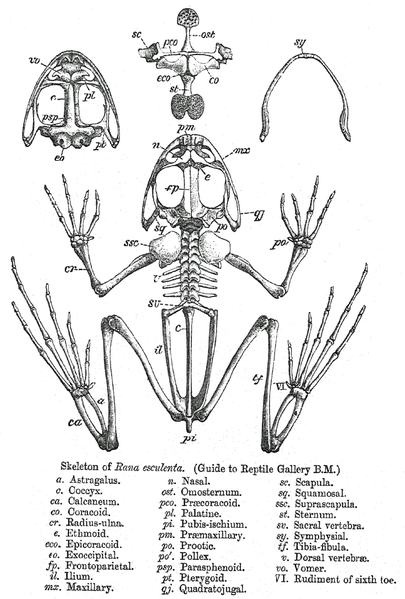File:Rana skeleton.png

Cabirka muuqaalkaan: 405 × 599 pixels. Waxyaabaha kale xalinta: 162 × 240 pixels | 324 × 480 pixels | 723 × 1,069 pixels.
Faylka asalka ah (723 × 1,069 pixels, weyninka faylka : 263 KB, nuuca MIME: image/png)
Taariikhda faylka
Riix taariikhda/waqtiga si aad u argto faylka sida oo ahaa markiisa hore.
| Taariikhda/Waqtiga | Sawir yar | Cabirka | Isticmaale | Ka hadalka | |
|---|---|---|---|---|---|
| kan hadda | 04:10, 1 Diseembar 2005 |  | 723 × 1,069 (263 KB) | Shyamal | Skeleton of frog. Rana Boulenger,GA 1890.The fauna of British India including Ceylon and Burma. Reptilia and Batrachia. Taylor and Francis |
Faylka lagu isticmaalay
waxyaabaha soo socda ee bog ayaa adeegsanaya faylkaan:
isticmaalka faylka aduunka
Wikisyada kale ee soosocda ayaa adeegsanaya faylka:
- Ku isticmaal als.wikipedia.org
- Ku isticmaal ar.wikipedia.org
- Ku isticmaal ast.wikipedia.org
- Ku isticmaal be.wikipedia.org
- Ku isticmaal bg.wikipedia.org
- Ku isticmaal ca.wikipedia.org
- Ku isticmaal ceb.wikipedia.org
- Ku isticmaal chr.wikipedia.org
- Ku isticmaal de.wikipedia.org
- Ku isticmaal en.wikipedia.org
- Ku isticmaal eo.wikipedia.org
- Ku isticmaal es.wikipedia.org
- Ku isticmaal fr.wikipedia.org
- Ku isticmaal gl.wikipedia.org
- Ku isticmaal gv.wikipedia.org
- Ku isticmaal he.wikipedia.org
- Ku isticmaal hy.wikipedia.org
- Ku isticmaal li.wikipedia.org
- Ku isticmaal lv.wikipedia.org
- Ku isticmaal mk.wikipedia.org
- Ku isticmaal ml.wikipedia.org
- Ku isticmaal oc.wikipedia.org
- Ku isticmaal or.wikipedia.org
- Ku isticmaal pl.wikipedia.org
- Ku isticmaal pt.wikipedia.org
- Ku isticmaal qu.wikipedia.org
- Ku isticmaal ru.wikipedia.org
- Ku isticmaal sah.wikipedia.org
- Ku isticmaal sr.wikipedia.org
- Ku isticmaal sv.wikipedia.org
- Ku isticmaal uk.wikipedia.org



